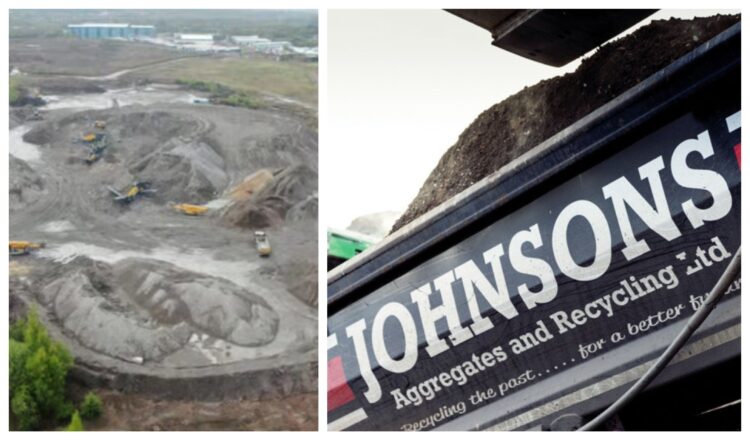A company hoping to expand its waste and recycling facility in Whittlesey, Cambridgeshire, has been ordered to pay £90,000 in costs and fines for breaking its environmental permit at its site in Derbyshire.
At Nottingham Magistrates’ Court on Friday 7 November 2025, Johnsons Aggregates and Recycling Ltd, of Crompton Road, Ilkeston, was fined £40,000 and ordered to pay costs of £49,886.75 for breaking its environmental permit.
The company had pleaded guilty at a previous hearing on 19 July 2025.
The Environment Agency told the court that ash which should have been contained onsite was spread over neighbouring land. Officers said, “large amounts of ash spread over five acres of adjoining land without permit.”
The waste, “a type of ash which is commonly used as an aggregate in construction,” was found by Environment Agency officers investigating “complaints about dust, odour and noise” at the Hallam Fields Industrial Estate, Ilkeston.
Company officials initially said, “the land was owned by someone else and was in the early stages of being developed,” and that “waste on the land had been placed there with the landowner’s permission and for the landowner’s use.”
However, Johnsons Aggregates later accepted “that it had made mistakes in dealing with waste and that it had breached its permit by placing the waste on the land.”
Compliance deadlines missed
The Environment Agency issued a compliance assessment report requiring the company to “operate within the boundary of the permit.”
When officers returned to the site on 11 May 2021, “large amounts of waste remained on site.”
Officials explained that “the waste had accumulated and had been more difficult to dispose of due to Covid.”
The company was told to remove the ash by 3 January 2022, but on 4 January 2022, officers found “the mounds of waste, though reduced in size, were still being stored and covered approximately 5 acres.”

An Environment Agency spokesperson said: “This case shows that operators in the waste sector should realise we will not tolerate illegal waste activities. We will take enforcement action to protect the environment, people and legitimate businesses.”
The public can report waste crime to the Agency’s hotline on 0800 807060, or Crimestoppers on 0800 555111.
Residents demand stronger oversight in Whittlesey
In Whittlesey, the Saxongate Residents Group has renewed calls for stronger environmental regulation following the Ilkeston prosecution.
The group campaigns for businesses “to follow rules and avoid needless pollution,” and says that “public confidence has eroded and long-term health and environmental risks remain under-examined.”
Saxongate took part in a multi-agency meeting this summer with Cambridgeshire County Council (CCC) and attended by town, district and county councillors, as well as a representative of local MP Steve Barclay.
CCC said the meeting was convened “partly because a lack of public trust had been recognised in how Saxon Pit has been regulated.”
Enforcement action underway at Saxon Pit
At the meeting, regulators including the Environment Agency, CCC, and Fenland District Council’s Environmental Health team “provided updates that indicated some enforcement actions had already taken place at Saxon Pit, with others ongoing.”
The UK Health Security Agency (UKHSA) has begun an “independent review into potential health risks linked to particulate matter at the site, including Incinerator Bottom Ash Aggregate (IBAA).”
According to officials, UKHSA scientists “are drawing on data from agencies and will test compliance against existing regulations. However, the adequacy of those standards themselves will not be examined in this review.”
“The review is expected to release its findings around Christmas or in early 2026.”
Extra site testing “has already been carried out,” though “the process will not include a public consultation.” Saxongate says it “will carefully scrutinise the findings.”
Planning application to expand Saxon Pit operations
Officials confirmed that a 2024 planning application by Johnsons Aggregates to increase annual IBA throughput at Saxon Pit from 250,000 tonnes to 460,000 tonnes “is unlikely to be heard this year.”
By comparison, the proposed Wisbech “mega incinerator” would produce around 125,000 tonnes of IBA annually.
The current Section 73 planning application (CCC/24/091/VAR) seeks to vary several conditions of the existing permission CCC/21/024/FUL, including those relating to “approved plans, hours of operation, vehicle movements, annual throughput of waste, and stockpile heights.”

According to the applicant’s Planning Statement, a successful outcome “will enable Johnson Aggregates & Recycling Ltd (JARL) to improve the company’s operational flexibility and enable the recycling facility to accommodate IBA material from other Energy from Waste (EfW) plants as they become operational.”
Town Council: ‘strongly recommends refusal’
Whittlesey Town Council has formally objected to the proposal.
In its submission to Cambridgeshire County Council, it said it “strongly recommends refusal of this application due to the significant and detrimental impact it would have on the health and well-being of Whittlesey residents.”
Concerns listed include “excessive dust, persistent noise pollution, harmful vehicle emissions, and a severe loss of residential amenity, such as the ability to enjoy private outdoor spaces.”
The site, at the former Saxon Brickworks, Peterborough Road, Whittlesey (PE7 1PD), handles the “importation, storage, processing including use of trommel, picking and recycling of incinerator bottom ash (IBA) and construction and demolition (C&D) waste, for exportation for use as incinerator bottom ash secondary aggregates (IBAA).”
Spotlight on Wisbech: concerns over monitoring gaps
While campaigning continues in Whittlesey, Saxongate has also turned its attention to the Medworth Energy-from-Waste plant being built in Wisbech.
The group has published a report, Beyond the Models – Medworth Monitoring, highlighting “critical gaps in the plant’s approved monitoring regime.”
According to the report, Medworth’s monitoring will include “continuous in-stack monitoring for pollutants such as particulates, nitrogen oxides and sulphur dioxide, along with twice-yearly tests for metals and dioxins.”
However, “off-site testing is limited to groundwater checks every five years and soil checks every ten,” while local air monitoring “will cover nitrogen dioxide and particulate matter (PM₁₀ and PM₂.₅) for four years after the plant becomes operational.”
The report warns: “The danger is that particle counts alone give a false sense of safety. The real test is chemical composition and long-term accumulation, not just short-term dust levels.”
‘You don’t take down smoke alarms’
Saxongate is calling for “baseline sampling before the Wisbech plant becomes operational, followed by ongoing biomonitoring of soil, crops, milk and meat for the life of the facility.”
It says: “There is no planned biomonitoring of soil, crops, milk, or meat to show whether contaminants are moving through the food chain. Without these checks, the community is asked to trust predictions that will never be tested.”
Fenland District Council has revoked Wisbech’s two Air Quality Management Areas, leaving the developer-funded Local Air Quality Monitoring Strategy as the only scheme in place — and that will run for only four years after operation begins.
Saxongate said: “You don’t take down smoke alarms just because you haven’t had a fire. “The same logic should apply here: health risks need checking for the life of the plant, not just the start.”
Community engagement and next steps
Saxongate says it hopes its Medworth report will “open a constructive discussion on how monitoring can be improved.”
The group says MVV has stated it “has no contract to send ash from Medworth to Whittlesey and that it is not part of current plans.”
Residents who believe they may be affected by issues linked to Saxon Pit are being urged to “contact the group directly for advice on the best routes for reporting concerns.”
Saxongate says it will “continue to hold regulators and operators to account — and keep pressing for stronger safeguards to protect both public health and the environment.”

















